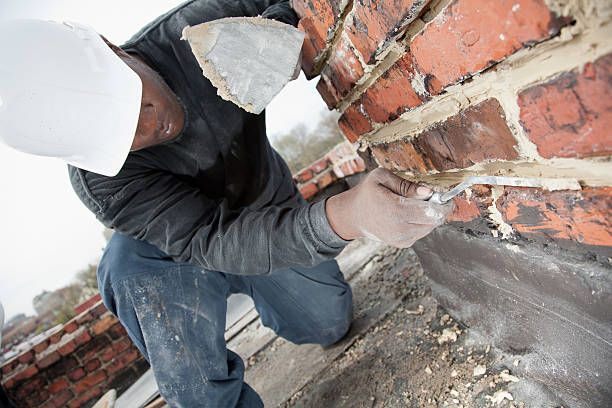Unlocking the Tricks of Lasting Stonework Building Practices for Eco-Friendly Buildings
Amongst the myriad techniques to green structure, lasting masonry building stands out as a reliable and durable technique that holds a wide range of untapped potential. From the selection of products to innovative building strategies, the keys to accomplishing sustainability within masonry construction are diverse and fascinating.
Benefits of Sustainable Masonry Building
Embracing sustainable masonry construction methods not just reduces ecological influence but additionally uses long-term financial benefits to building contractors and neighborhoods. By using materials like recycled bricks, obstructs, and stones, contractors can dramatically reduce the carbon footprint of their jobs while advertising resource performance. Furthermore, sustainable stonework building and construction methods, such as proper insulation and thermal mass residential properties, can boost power effectiveness within structures, bring about lowered operational costs gradually.
Moreover, the resilience and strength of masonry frameworks add to long-lasting financial benefits. Structures created making use of lasting masonry practices typically require less maintenance and repair service, equating to set you back savings for home builders and homeowner. The longevity of stonework products likewise ensures that frameworks stay secure and protected, lowering the need for frequent improvements or replacements.
Eco-Friendly Masonry Products
Using environment-friendly stonework materials is a crucial action towards improving the sustainability of building practices and decreasing ecological effect while maximizing long-lasting financial advantages. Sustainable masonry materials are sourced, produced, and utilized in a fashion that reduces total environmental impact. Sustainable concrete blocks integrate recycled aggregates and might include improved insulation residential or commercial properties, adding to energy performance in buildings.
In addition, all-natural products like adobe, rammed earth, and straw bales give superb thermal mass properties, reducing the need for heating and cooling energy. These products are often in your area readily available, promoting local economies and minimizing transportation-related carbon emissions. By selecting eco-friendly masonry materials, building and construction tasks can significantly reduce their environmental footprint and contribute to the production of healthier, more sustainable developed environments.
Energy-Efficient Masonry Techniques
Energy efficiency plays an important function in boosting the sustainability of masonry building and construction practices. By executing energy-efficient stonework strategies, contractors can considerably reduce the total power consumption of a structure, resulting in lower functional expenses and a smaller sized ecological footprint. One crucial energy-efficient stonework method is using thermal mass, which entails including dense materials like concrete or brick into the structure's structure to soak up and store heat. This helps control interior temperatures, reducing the requirement for mechanical home heating and cooling down systems.

Advancements in Lasting Stonework
Recent developments in lasting masonry methods have brought around cutting-edge strategies that are improving the building industry. One such technology is the advancement of self-healing concrete, which makes use of bacteria embedded within the concrete to heal fractures autonomously. article source This advancement not just lowers upkeep prices but likewise enhances the sturdiness of stonework frameworks, adding to their sustainability.
An additional significant development is making use of recycled aggregates in stonework building and construction - masonry contractor. By incorporating materials such as smashed ceramic waste or recycled glass into concrete mixes, contractors can reduce the environmental effect of building and construction projects while preserving architectural honesty. This practice not only diverts waste from land fills however additionally saves natural resources, making it an essential improvement in sustainable masonry building and construction
Furthermore, the assimilation of electronic layout devices, such as Building Info Modeling (BIM), is reinventing the method stonework frameworks are intended and link constructed. BIM enables even more accurate calculations, reduced material wastefulness, and improved energy performance, inevitably resulting in more lasting building techniques. These innovations collectively represent a promising future for lasting masonry building and construction in the era of environmentally friendly structures.
Future Trends in Masonry Sustainability
With the ingenious strides made in lasting masonry techniques, the future fads in masonry sustainability are poised to further change the construction sector. Among the crucial patterns forming the future of stonework sustainability is the increased combination of technology. Advancements such as Structure Information Modeling (BIM) and digital fact simulations are being used to maximize stonework construction processes, bring about decreased material waste and improved power performance in buildings.
In addition, the advancement of unique sustainable materials is readied to play a considerable role in boosting the eco-friendliness of stonework construction. masonry contractor. Developments like self-healing see this concrete, recycled aggregates, and bio-based binders are obtaining traction for their ability to reduce environmental effect while maintaining structural integrity

Conclusion
In verdict, lasting stonework construction methods use numerous benefits for green structures. By using eco-friendly products and energy-efficient strategies, masonry can add to an extra lasting built atmosphere. Advancements in lasting masonry are continuously being developed to additionally boost the environmental efficiency of structures. Looking in the direction of the future, the fad of masonry sustainability is anticipated to expand, causing even more eco friendly and energy-efficient building and construction techniques in the years to find.